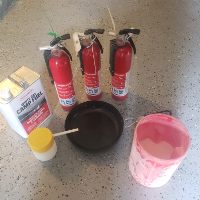Experiment #1
Since our initial blog, we’ve had some time to think about what we needed in order to officially begin building our firefighting device. One of the most crucial components of the device that will dictate its design, efficacy, and overall size is the type of chemical compound that we use. The device’s goal will still be to extinguish a kitchen fire as soon as it starts by delivering an accurate stream of fire retardant chemical to the targeted area, but how we deliver the compound will be dependent on the properties of the compound such as density and state (solid or liquid). We then decided to perform a few experiments in order to find out which chemical compound will work best. We know that our target fire is a class K fire, which encompasses fires that start on grease, animal fat, vegetable oil, and cooking oils. During our research, we found that obtaining the necessary compounds to put out class K fires would not be an easy task. Most of the class K fire equipment is sold in the form of large extinguishers that are too bulky to fit within our ideal device. We wanted just the raw component, which is sold by big fire equipment companies in large quantities with a high price tag. In our case, we just needed small quantities of various compounds in our small experiment. After researching online, we decided to see if we could try to meet up with some vendors who might be able to give us advice for our project and experiment.
In order to learn more background about the process of firefighting, we decided to take a day to visit various fire equipment vendors around the Pasadena area and pick up some materials for our very first experiment. After a few visits to Home Depot and Academy, we acquired the components needed for our experiment.
We were able to learn more about fire extinguishing materials through A1 Fire Equipment Co. Inc. The Fire Extinguisher Manager, Billy Copaus, assisted us in answering our questions about proper fire extinguishing powders that would be efficient in putting out a cooking fire. He was also generous enough to gift us 3 fire extinguishers and Monoammonium phosphate powder to run preliminary trials with.

Now having the fire extinguishing materials and rudimentary components for our design, we began to test the concept of putting out an oil-based fire. To do this we set alight a cup of oil in a regular cooking pan. Our rudimentary components consisted of a dust blower with a storage chamber. We filled the storage chamber with the Monoammonium Phosphate powder. As one presses down on this chamber, the powder is forced out of the nozzle onto the intended target. This method of ejecting the fire extinguishing powder looked promising as it extinguished the fire from an appropriate distance. We intend to modify this solution as we further our research into the design.
Another problem that we started to explore was the type of camera that we were going to use. We were initially planning to use a thermal camera to capture the high temperatures of an out of control flame. These out of control flames would be detected after they rose past a preset datum line that we could code into the camera’s footage. But after giving the task more thought, we realized that not only would this code be arduous, the use of a datum line would deprive our device of the ability to sense accidental fires with flammable objects right next to the burning stove such as paper towels, rags, or other cooking equipment. After further discussions, we realized that the fires on a gas stove are typically blue. Only the tips of the fires are slightly yellow. Typically, when something catches on fire in a kitchen, whether it be food or flammable objects, it burns bright yellow. Our solution to the camera problem that we initially posed could be solved by using a normal light-detecting camera that can pinpoint yellow flames with a preset threshold value for intensity. For our goal, the range of the device was also subsequently changed from the original 6 feet to 3 feet because we did not need more than 3 feet in order to cover the area of a kitchen stove.
Comments
Post a Comment